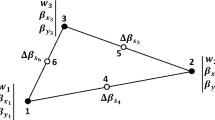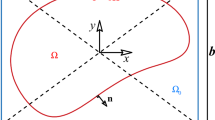Abstract
In this work, the plate bending formulation of the boundary element method (BEM) based on the Kirchhoff's hypothesis, is extended to the analysis of stiffened elements usually present in building floor structures. Particular integral representations are derived to take directly into account the interactions between the beams forming grid and surface elements. Equilibrium and compatibility conditions are automatically imposed by the integral equations, which treat this composite structure as a single body. Two possible procedures are shown for dealing with plate domain stiffened by beams. In the first, the beam element is considered as a stiffer region requiring therefore the discretization of two internal lines with two unknowns per node. In the second scheme, the number of degrees of freedom along the interface is reduced by two by assuming that the cross-section motion is defined by three independent components only.
Similar content being viewed by others
Author information
Authors and Affiliations
Additional information
Received 6 November 2000
Rights and permissions
About this article
Cite this article
Fernandes, G., Venturini, W. Stiffened plate bending analysis by the boundary element method. Computational Mechanics 28, 275–281 (2002). https://doi.org/10.1007/s00466-001-0287-6
Issue Date:
DOI: https://doi.org/10.1007/s00466-001-0287-6




